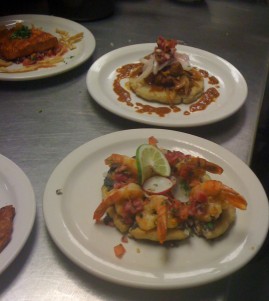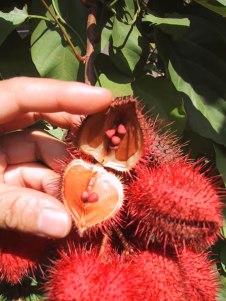 A couple of weeks ago in my Cuisines of Mexico class, we worked with an interesting ingredient called Achiote, made from Annatto seeds, which incidentally comes from the Annatto tree. It’s very prevalant in Yucatecan cooking, which differs considerably from the rest of Mexican cooking.
A couple of weeks ago in my Cuisines of Mexico class, we worked with an interesting ingredient called Achiote, made from Annatto seeds, which incidentally comes from the Annatto tree. It’s very prevalant in Yucatecan cooking, which differs considerably from the rest of Mexican cooking.
Why? The Yucatan peninsula is somewhat isolated geographically from the rest of Mexico, because it’s surrounded by mountains on 1 side and water on the other 3. Because of their commercial sea ports, they have long been influenced by European, Caribbean, and Cuban cooking and ingredients. As a result, you’ll find greater use of citrus and fruits, such as lime, sour orange, bananas and plantains, and the habanero pepper is very popular in this region.
The cuisine is lighter, but also earthy, which may seem like a contradiction, but it’s not. The earthy flavors are balanced by a heavy hand with lime, citrus, and sweeter flavors contributed by fruits.
The annatto seeds are small and extremely hard. A few years ago, these were very hard to come by, but now, even Williams-Sonoma sells them, so there ya go. Don’t say the foodie revolution never did anything for you.
At Chef Carlos’ restaurant, Mexique, he uses the seeds, but he soaks them for at least a day before he grinds them for use in his dishes.
The flavor is pleasantly earthy, but still must be balanced with acid or your dish will be “off.”
One of the more famous or well-known dishes using Achiote is cochinita or pollo (chicken) pibil. You begin with a pork shoulder roast, rub it with an achiote paste, wrap it in banana leaves, and cook it in a pit in the ground, or “pib.”
Ha! Yes, that’s the traditional means of cooking in the Yucatan, but you can get great results by using your dutch oven and cooking it in your stove for a few hours, as you would pulled pork. The banana leaf and the achiote paste gives it a very unique flavor. It’s not like anything else I’ve had – and I’m a adventurous eater!
I think the recipe we used in class was just OK, so I recommend using Rick Bayless’ version. He actually calls for the seeds, but if you can’t find them and don’t want to order them online, you can easily substitute the powdered achiote, and your results will be just as good.
The cooked pork can be used for tacos or a tamale filling. Or just eat it “straight up.”
In class, we also used achiote paste on shrimp, salmon, and pounded pork cutlets, or “Poc chuc.”
These are the dishes Chef Carlos assembled:

In the foreground, achiote shrimp with black beans and a thick masa tortilla commonly griddled, split, and stuffed - similar to a pupusa. Behind the shrimp is the cochinita pibil and back left is the salmon. Common accompaniments are habanero salsa, radishes, lime, and pickled onions.
P.S. We also made a charred pepper paste very popular in Yucatecan cooking called “Chilmole” or “Recado Negro.” I brought it home and used a couple of tablespoons in a chili recipe, and it was fantastic! A lot of this stuff is easy and adds so much flavor. It’s well worth learning these techniques and recipes!

March 3, 2011 at 10:19 am
Oooh I’ve got a good recipe for pork tacos that uses annatto seeds! I love them! You can buy them at The Spice House online or here in Chicago. This recipe is from Big Star, that amazing honky tonk taco joint in Wicker Park. If you’ve got them at home you have to try this Kris! http://kitchenbitchblog.com/2010/09/03/best-ever-grilled-pork-tacos/ Thanks for sharing! I have got to take this class!
March 4, 2011 at 8:28 am
Thanks! Those look amazing – and very much like some of the things we’ve been making in class, except for the coca cola (!?!). Definitely have to try these!
BTW, Spice House came to Milwaukee first and they’re right downtown. Hey, us Milwaukeeans have to claim credit where we can. It’s tough being a little sister to Chicago. 😉
March 4, 2011 at 9:31 am
Ha, lol, who knew! I thought their only locations were here. Now I want them to go to Cincinnati!
March 17, 2011 at 11:45 am
Well, they’ll ship anywhere, but it only makes sense if you’re doing a larger order. If you’re just ordering one or two things, the shipping will cost more than the spices!
BTW, I lived in the Cincinnati area for five years. What part?
March 17, 2011 at 11:50 am
Oh yeah, I showed my mom the SH, and now she orders her spices from there, too. My family lives in Northern Kentucky, close to Covington. Although we lived on East McMillan for awhile, right by St. Ursula Academy.
March 17, 2011 at 11:44 am
In Yucatecan cooking, they grind the seeds into a paste, as you did in your recipe. In Puerto Rican cooking, with which I’m more familiar, they cook the seeds in oil or lard to color and flavor the fat, then strain out and discard the seeds. It’s not uncommon to make a larger batch of “achiote coloring” and refrigerate it for longer-term use, a couple of tbsp at a time. Two of my favorite Puerto Rican dishes, arroz con pollo and asopao, begin with achiote coloring.
March 17, 2011 at 11:53 am
@KB: I lived in Symmes Township until the tornado of ’99 knocked over our apartment comples, and then in Loveland until about 2002. If I had it to do over again, I’d have lived in Pleasant Ridge or maybe Norwood/Hyde Park.
December 24, 2013 at 3:20 am
We’re a bunch of volunteers and opening a brand new scheme in our community. Your site provided us with useful info to paintings on. You have done an impressive job and our whole community will be grateful to you.